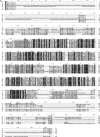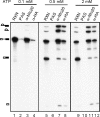Splicing factor Cwc22 is required for the function of Prp2 and for the spliceosome to escape from a futile pathway
- PMID: 20956557
- PMCID: PMC3019855
- DOI: 10.1128/MCB.00801-10
Splicing factor Cwc22 is required for the function of Prp2 and for the spliceosome to escape from a futile pathway
Abstract
Cwc22 was previously identified to associate with the pre-mRNA splicing factor Cef1/Ntc85, a component of the Prp19-associated complex (nineteen complex [NTC]) involved in spliceosome activation. We show here that Cwc22 is required for pre-mRNA splicing both in vivo and in vitro but is neither tightly associated with the NTC nor required for spliceosome activation. Cwc22 is associated with the spliceosome prior to catalytic steps and remains associated throughout the reaction. The stable association of Cwc22 with the spliceosome requires the presence of the NTC but is independent of Prp2. Although Cwc22 is not required for the recruitment of Prp2 to the spliceosome, it is essential for the function of Prp2 in promoting the release of the U2 components SF3a and SF3b. In the absence of Cwc22, Prp2 can bind to the spliceosome but is dissociated upon ATP hydrolysis without promoting the release of SF3a/b. Thus, Cwc22 represents a novel ATP-dependent step one factor besides Prp2 and Spp2 and has a distinct role from that of Spp2 in mediating the function of Prp2.
Figures








References
-
- Bessonov, S., M. Anokhina, C. L. Will, H. Urlaub, and R. Lührmann. 2008. Isolation of an active step I spliceosome and composition of its RNP core. Nature 452:846-850. - PubMed
-
- Chan, S.-P., and S.-C. Cheng. 2005. The Prp19-associated complex is required for specifying interactions of U5 and U6 with pre-mRNA during spliceosome activation. J. Biol. Chem. 280:31190-31199. - PubMed
-
- Chan, S.-P., D.-I. Kao, W.-Y. Tsai, and S.-C. Cheng. 2003. The Prp19p-associated complex in spliceosome activation. Science 302:279-282. - PubMed
Publication types
MeSH terms
Substances
LinkOut - more resources
Full Text Sources
Molecular Biology Databases
Miscellaneous
